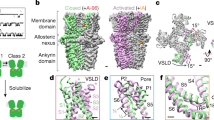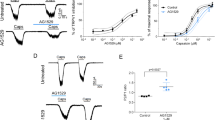Abstract
Wasabi, horseradish and mustard owe their pungency to isothiocyanate compounds. Topical application of mustard oil (allyl isothiocyanate) to the skin activates underlying sensory nerve endings, thereby producing pain, inflammation and robust hypersensitivity to thermal and mechanical stimuli1,2. Despite their widespread use in both the kitchen and the laboratory, the molecular mechanism through which isothiocyanates mediate their effects remains unknown. Here we show that mustard oil depolarizes a subpopulation of primary sensory neurons that are also activated by capsaicin, the pungent ingredient in chilli peppers, and by Δ9-tetrahydrocannabinol (THC), the psychoactive component of marijuana. Both allyl isothiocyanate and THC mediate their excitatory effects by activating ANKTM1, a member of the TRP ion channel family recently implicated in the detection of noxious cold3,4. These findings identify a cellular and molecular target for the pungent action of mustard oils and support an emerging role for TRP channels as ionotropic cannabinoid receptors5,6,7,8.
This is a preview of subscription content, access via your institution
Access options
Subscribe to this journal
Receive 51 print issues and online access
$199.00 per year
only $3.90 per issue
Buy this article
- Purchase on Springer Link
- Instant access to full article PDF
Prices may be subject to local taxes which are calculated during checkout




Similar content being viewed by others
References
Wall, P. D. & Melzack, R. The Textbook of Pain (W. B. Saunders, London, 1999)
Jancso, N., Jancso-Gabor, A. & Szolcsanyi, J. Direct evidence for neurogenic inflammation and its prevention by denervation and by pretreatment with capsaicin. Br. J. Pharmacol. 31, 138–151 (1967)
Jaquemar, D., Schenker, T. & Trueb, B. An ankyrin-like protein with transmembrane domains is specifically lost after oncogenic transformation of human fibroblasts. J. Biol. Chem. 274, 7325–7333 (1999)
Story, G. M. et al. ANKTM1, a TRP-like channel expressed in nociceptive neurons, is activated by cold temperatures. Cell 112, 819–829 (2003)
Zygmunt, P. M. et al. Vanilloid receptors on sensory nerves mediate the vasodilator action of anandamide. Nature 400, 452–457 (1999)
Bisogno, T. et al. Molecular targets for cannabidiol and its synthetic analogues: effect on vanilloid VR1 receptors and on the cellular uptake and enzymatic hydrolysis of anandamide. Br. J. Pharmacol. 134, 845–852 (2001)
Di Marzo, V., Bisogno, T. & De Petrocellis, L. Anandamide: some like it hot. Trends Pharmacol. Sci. 22, 346–349 (2001)
Ross, R. A. Anandamide and vanilloid TRPV1 receptors. Br. J. Pharmacol. 140, 790–801 (2003)
Lembeck, F. & Holzer, P. Substance P as neurogenic mediator of antidromic vasodilation and neurogenic plasma extravasation. Naunyn Schmiedebergs Arch. Pharmacol. 310, 175–183 (1979)
Louis, S. M., Jamieson, A., Russell, N. J. & Dockray, G. J. The role of substance P and calcitonin gene-related peptide in neurogenic plasma extravasation and vasodilatation in the rat. Neuroscience 32, 581–586 (1989)
Szallasi, A. & Blumberg, P. M. Vanilloid (capsaicin) receptors and mechanisms. Pharmacol. Rev. 51, 159–212 (1999)
Caterina, M. J. et al. The capsaicin receptor: a heat-activated ion channel in the pain pathway. Nature 389, 816–824 (1997)
Tominaga, M. et al. The cloned capsaicin receptor integrates multiple pain-producing stimuli. Neuron 21, 531–543 (1998)
Montell, C., Birnbaumer, L. & Flockerzi, V. The TRP channels, a remarkably functional family. Cell 108, 595–598 (2002)
Jordt, S. E., McKemy, D. D. & Julius, D. Lessons from peppers and peppermint: the molecular logic of thermosensation. Curr. Opin. Neurobiol. 13, 487–492 (2003)
Clapham, D. E. TRP channels as cellular sensors. Nature 426, 517–524 (2003)
Reeh, P. W., Kocher, L. & Jung, S. Does neurogenic inflammation alter the sensitivity of unmyelinated nociceptors in the rat? Brain Res. 384, 42–50 (1986)
Caterina, M. J. et al. Impaired nociception and pain sensation in mice lacking the capsaicin receptor. Science 288, 306–313 (2000)
Jancso, G., Kiraly, E. & Jancso-Gabor, A. Pharmacologically induced selective degeneration of chemosensitive primary sensory neurones. Nature 270, 741–743 (1977)
Simons, C. T., Carstens, M. I. & Carstens, E. Oral irritation by mustard oil: self-desensitization and cross-desensitization with capsaicin. Chem. Senses 28, 459–465 (2003)
Caterina, M. J. & Julius, D. The vanilloid receptor: a molecular gateway to the pain pathway. Annu. Rev. Neurosci. 24, 487–517 (2001)
Zygmunt, P. M., Andersson, D. A. & Hogestatt, E. D. Δ9-Tetrahydrocannabinol and cannabinol activate capsaicin-sensitive sensory nerves via a CB1 and CB2 cannabinoid receptor-independent mechanism. J. Neurosci. 22, 4720–4727 (2002)
Wilson, R. K., Kwan, T. K., Kwan, C. Y. & Sorger, G. J. Effects of papaya seed extract and benzyl isothiocyanate on vascular contraction. Life Sci. 71, 497–507 (2002)
Patacchini, R., Maggi, C. A. & Meli, A. Capsaicin-like activity of some natural pungent substances on peripheral endings of visceral primary afferents. Naunyn Schmiedebergs Arch. Pharmacol. 342, 72–77 (1990)
McKemy, D. D., Neuhausser, W. M. & Julius, D. Identification of a cold receptor reveals a general role for TRP channels in thermosensation. Nature 416, 52–58 (2002)
Peier, A. M. et al. A TRP channel that senses cold stimuli and menthol. Cell 108, 705–715 (2002)
Rang, H. P., Bevan, S. & Dray, A. in Textbook of Pain (eds Wall, P. D. & Melzack, R.) 57–78 (Churchill-Livingstone, London, 1994)
Smart, D. et al. The endogenous lipid anandamide is a full agonist at the human vanilloid receptor (hVR1). Br. J. Pharmacol. 129, 227–230 (2000)
Jordt, S. E., Tominaga, M. & Julius, D. Acid potentiation of the capsaicin receptor determined by a key extracellular site. Proc. Natl Acad. Sci. USA 97, 8134–8139 (2000)
Acknowledgements
We are grateful to G. Hollopeter for generation of the adult rat trigeminal cDNA library and to B. Trueb for providing us with human ANKTM1 cDNA. This work was supported by grants from the Segerfalk Foundation and the Swedish Research Council (P.Z. and E.H.), the American Heart Association (H.C.) and the National Institutes of Health (I.M., D.B. and D.J.).
Author information
Authors and Affiliations
Corresponding author
Ethics declarations
Competing interests
The authors declare that they have no competing financial interests.
Supplementary information
41586_2004_BFnature02282_MOESM2_ESM.pdf
Supplementary Figure 2: Effects of cold on mustard oil-evoked currents in Xenopus oocytes expressing human ANKTM1. (PDF 62 kb)
41586_2004_BFnature02282_MOESM3_ESM.pdf
Supplementary Figure 3: Effects of intracellular Ca2+-chelation on receptor operated activation of the Ca2+-dependent chloride current in Xenopus oocytes. (PDF 77 kb)
Rights and permissions
About this article
Cite this article
Jordt, SE., Bautista, D., Chuang, Hh. et al. Mustard oils and cannabinoids excite sensory nerve fibres through the TRP channel ANKTM1. Nature 427, 260–265 (2004). https://doi.org/10.1038/nature02282
Received:
Accepted:
Published:
Issue Date:
DOI: https://doi.org/10.1038/nature02282
This article is cited by
-
A novel small molecule, AS1, reverses the negative hedonic valence of noxious stimuli
BMC Biology (2023)
-
TRPA1 promotes the maturation of embryonic stem cell-derived cardiomyocytes by regulating mitochondrial biogenesis and dynamics
Stem Cell Research & Therapy (2023)
-
Thermoring basis for the TRPV3 bio-thermometer
Scientific Reports (2023)
-
TRPA1 activation in non-sensory supporting cells contributes to regulation of cochlear sensitivity after acoustic trauma
Nature Communications (2023)
-
Molecular mechanism of hyperactivation conferred by a truncation of TRPA1
Nature Communications (2023)
Comments
By submitting a comment you agree to abide by our Terms and Community Guidelines. If you find something abusive or that does not comply with our terms or guidelines please flag it as inappropriate.



